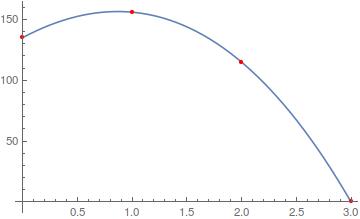What is the rule of the cubic function for which the graph passes through the points with coordinates (0,135), (1,156), (2,115), (3,0)?
2 Answers
See below.
Explanation:
The simpler way to solve this question, assuming the cubic function is given by
or
Solving for
Attached a plot showing the interpolation.

Explanation:
Since the
Write down the initial sequence of
color(blue)(135), 156, 115, 0
Write down the sequence of differences between successive terms:
color(blue)(21), -41, -115
Write down the sequence of differences of those differences:
color(blue)(-62), -74
Write down the sequence of differences of those differences:
color(blue)(-12)
Having reached a constant sequence (albeit of just one term), we can use the initial term of each of these sequences as coefficients to find the formula:
f(x) = color(blue)(135)/(0!)+color(blue)(21)/(1!)x+color(blue)(-62)/(2!)x(x-1)+color(blue)(-12)/(3!)x(x-1)(x-2)
color(white)(f(x)) = 135+21x-31x^2+31x-2x^3+6x^2-4x
color(white)(f(x)) = -2x^3-25x^2+48x+135


